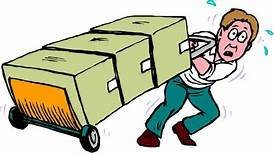How to Lift Safely and How to Move with a Hand Truck
The Hand Truck Company’s tag line is “protect your back, protect your products.” We know that there are several ways to prevent injuries when moving objects such as furniture, boxes, plywood, products, barrels, kegs, etc.
Not every company, delivery service, or warehouse is equipped with state-of-the-art robotics or technology that eliminates the use of actual humans. Even those companies that use technology to move items often have front-line team members using their backs to keep the distribution system moving. We’ll provide some safety tips that might alleviate or reduce injuries for your front-line team.
Team members are like robots in that they can physically break down at the most unexpected times. Strains, sprains, and back injuries often occur when moving products or heavy items. Illnesses can pop up at any time.
It is the responsibility of company leaders to prepare for the potential injuries and illnesses that will occur. While businesses have to make a profit, too many do it at the expense of the front-line workers. On-going safety training will reduce those occurrences.
Push, don’t pull a hand truck! Not only is it harder on your back and shoulders, you can’t see where you’re going!
Hand Trucks or Dollies
Whatever you call them (the two-wheeler is technically a hand truck), millions, if not billions, of hand trucks are used daily throughout the world. The following suggestions apply to most hand trucks, whether your company is using a basic two-wheeler or a specialty hand truck.
Here are a few tricks to using a hand truck that may make moving just a bit safer:
1) Use a hand truck that is appropriate for the job or load to be carried. Check for the load limit if you are moving something over 250 lbs.
2) When stacking boxes, place the heaviest load on the bottom. DO NOT stack the boxes so high that you can't see where you're going
3) Position the load forward over the axles so the truck, not the handles, carries the weight
4) Clear your path
5) Don't walk backwards. It's safer to push rather than pull (I see way too much of this!)
6) Keep the hand truck under control, especially if going downhill or down a truck ramp
7) Tie or secure any bulky, awkward, or delicate objects
8) Wear sturdy shoes with nonskid soles
9) Let the hand truck do the work for you
10) Allow your team a sufficient amount of time to move items safely and securely.(1)
Don’t do this: NO! Scary falling boxes
Do this: YES! Protect your front line team with our Attachit Strap with an Erickson retractable ratchet for most dollies and hand trucks
How to Lift Properly
Everybody should know that you lift with your legs and not your back, but a young team member might not know or another might have something else on his/her mind and not be thinking about the job at hand. Remind them in a safety meeting of the following that the Mayo Clinic has published (2):
Don’t do this! Start in a safe position.
NO! Always Lift with your legs
Before you lift a heavy object, think through your task. Decide where you're going to place the object and how you'll get it there. If an object is too heavy to lift safely, ask someone to help you. If possible, break down a load into smaller units.
When lifting an object from the floor, stand close to the object. Don't lift from a standing position with your waist bent or your knees locked.
One option for proper lifting is to kneel, resting one knee on the floor. Click on the links below for a slide show from the Mayo Clinic:
How to Prevent Muscle Strains
With all the work activity going on, sometime the basic prevention of muscle strains and sprains is often overlooked.
Ample rest between strenuous jobs is a simple prevention. Anytime a team member does arduous activity, you have to allow for time to recover. Not doing so increases the likelihood of muscle fatigue, strained muscles, and stress fractures. (3)
Safety Meetings
Hold regularly scheduled safety meetings for your team. Or better yet, have a quick daily talk since material handling is the number one source of on-the-job accidents.(4)
The ABC 2020 Safety Performance Report found that companies that conduct daily toolbox safety meetings reduce the total recordable incident rate (TRIR) by 82%, compared to companies that hold them monthly.
An effective safety toolbox talk contains four key topics that can be covered in 5-10 minutes:
goal/management expectation
personal protection equipment expectation and usage
best practices
post-accident response expectations
For additional advice on conducting daily toolbox safety meetings, click here: https://www.constructionexec.com/article/reduce-workplace-injuries-with-five-minute-toolbox-talks
Make sure that your meetings are interactive. Listen to the concerns and suggestions that the front-line workers have for the team and management.
Equipment
Who really knows how many hand trucks are available for that last mile material handling? A basic two-wheeler with an available ratchet strap might just be what your team needs to get the job done safely.
The Only Multi-directional Hand Truck 360 Available for Safer Moving
But-now I’m giving a little sales pitch here-there are many specialty hand trucks manufactured for a specific job. We have the only available multi-directional Hand Truck 360 that safely moves items of all shapes and sizes by one person in tight spaces, saving both time and money. And, it’s made in the USA. Look for a whitepaper coming soon on how our products can reduce sprains, strains, and worker comp claims.
CONCLUSION
The bottom line is, protect your front line workers with the equipment that’s right for them and the jobs that they perform.
Follow basic safety guidelines.
Have a regular safety meeting with the involvement of team members who are actually moving products.
Remember that your team members aren’t robots!###
Judy Kochevar, President
https://www.thehandtruckcompany.com
1 www.toolboxtopics.com/Gen%20Industry/Safe%20Use%20of%20Hand%20Trucks.htm
2 https://www.mayoclinic.org/healthy-lifestyle/adult-health/multimedia/back-pain/sls-20076866
3 https://www.completecare.com
4 https://www.constructionexec.com/article/reduce-workplace-injuries-with-five-minute-toolbox-talks




